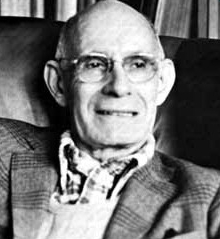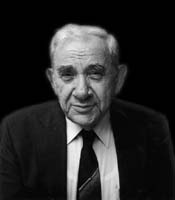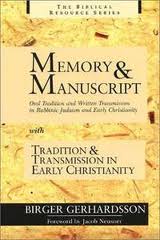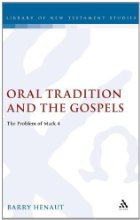How did the Gospel authors learn about Jesus? They are generally thought to have only begun writing forty years after the death of Jesus — from the time of the destruction of the Jerusalem Temple around the conclusion of the Jewish-Roman War of 66 to 73 CE. Historical Jesus scholars have (reasonably) assumed that that gap of forty years was filled mostly by followers of Jesus, and followers of those followers, passing on the stories of Jesus by word of mouth. With this chain of “oral tradition” securing the events of Jesus to the gospels we can have some confidence that what we read in Mark, Matthew, Luke (and some would say even John) has some real connection to what historically happened in Galilee and Jerusalem during the time of the governorship of Pilate.
However, scholars need more than assumption. They need evidence. So how can one have evidence of the contents of conversations that people relayed by word of mouth to each other many generations ago? The answer is in the way the words came together in the earliest gospel narratives.
- Do they betray traces of the way people naturally speak compared with the way they write more formal or literary prose?
- Are the gospels themselves, or at least the supposed earliest gospel, Mark, quite “unliterary” and clearly a crude compilation of oral reports?
- By comparing the other gospels with Mark can scholars see patterns of how stories were modified and extrapolate back to how they must have changed during the oral transmission process?
Can modern historians (e.g. Jan Vansina) who specialize in oral histories of African peoples help us out here? What about scholars who study the oral transmission of epic tales told among the Balkan peoples? Does research into the psychology of memory help us out? Can we combine these studies with new philosophical approaches to the nature of history and “evidence” to write a valid history of Jesus?
Much work has been done by New Testament scholars exploring all of the above pathways in their efforts to arrive at what Jesus “probably” or “plausibly” did and said. Through such processes many scholars have concluded that the parables of Jesus are the most “certainly” indicative of Jesus’ original teachings.
Meanwhile, Doctor Doubting Thomas is kept waiting outside.
Several scholars have published studies that argue the gospel narratives are based upon other literary stories, especially others found in the Old Testament. Some have even challenged those arguments that claimed to have found evidence of orality in the gospels. One of these, Barry W. Henaut, has argued that even the parables of Jesus as told in the oldest gospel, Mark, are more certainly derived not from oral tradition but are indeed literary creations of the author.
In Oral Tradition and the Gospels Henaut has investigated the arguments that the narratives and saying of Jesus in the gospels are derived from oral tradition and found them to be all based on questionable assumptions. A closer look actually indicates that the same evidence is more validly a sign that the gospel writings are indeed literary creations and not attempts to document or edit oral reports.
The previous post in this series concluded with questioning the arguments of Bultmann and form critics that presupposed “oral tradition” as the source of Gospel narratives about Jesus.
This post looks critically at the oral tradition arguments of one of the more significant critiques of form criticism, the “Memory and Manuscript” school of Harald Riesenfeld and his pupil Birger Gerhardsson. These Swedish scholars looked to the processes of transmission apparent within rabbinic Judaism as the model for oral transmission of the words and sayings of Jesus.
Since there were indications that the Jewish rabbis passed on certain teachings by means of oral tradition until these were put in writing around 200 CE (the Mishnah), was it fair to suggest that the teachings of Jesus were passed on in a similar way by his disciples?
Yes, if the portrayal of the apostles in Acts 6:2 is reliable. There the apostles are said to be primarily responsible for preaching and teaching. And the earliest messages they are depicted as giving are outlines of the life of Jesus.
Besides, Paul’s letters can be read as if they are alluding indirectly to the sayings of Jesus. Scholars have read them as if they assume a knowledge of the teachings and deeds of Jesus that must have been passed on by oral tradition. And does not Paul speak of doctrines being “received”? What else can this mean other than oral transmission?

The rabbis, Riesenfeld pointed out, likewise orally transmitted teachings. They did so within a controlled process, however. A leading rabbi had the supervisory function of this transmission. The words passed on and remembered were rigidly controlled. Pupils who were invited to share this privilege were especially approved. Pearls were not entrusted to any old swine who snorted an interest. The whole process was formally controlled by rabbinic supervisors and pupils who had proven themselves reliable to ensure that not “one iota of the tradition” would be lost.
This was surely the model behind the apostolic teaching in Acts 6:2 and that formed the background to Paul’s letters.
Hence the Gospel tradition was not shaped by an unlimited and anonymous multitude, but transmitted by an exactly defined group within the community. (Riesenfeld, Gospel Tradition, p. 16)
We have seen the resurgence of a similar model of oral tradition behind the Gospels more recently with Richard Bauckham’s Jesus and the Eyewitnesses. (That link is to my own posts addressing Bauckham’s book.)
Jan Vansina strikes again

Let’s roll with this model for a moment. Let’s assume oral transmission of the Jesus stories. How reliably would any genuine history be passed on to reach the gospel authors? Oral historian Jan Vansina has much to teach us about the reliability of oral transmission.
So I was not surprised to find in Henaut’s study further reference to Vansina’s work that, yes, yet another New Testament model of oral transmission finds no support in the research evidence from the highly regarded oral historian.
Here is Henaut drawing on Vansina’s studies to show why this “rabbinic model” of oral transmission cannot validly support the idea that traditions about Jesus were reliably transmitted through any number of years:
Even granting the role of eyewitnesses in the formation of the tradition, a problem emerges. Historians emphasize that for eyewitness accounts to be accurate three elements must be present: the witnesses should have been
- able to see;
- able to understand what was seen; and
- not so involved in the action that their own role would have affected what they saw and remembered.
Jan Vansina points out that soldiers’ reports of battles, for example, are usually deficient in the last two aspects. Hence:
Eyewitness accounts are only partly reliable. Certainly it is true that complex (battle) or unexpected (accidents) events are perhaps rarer than simple, expected events. Yet even here the account remains imperfect. The expectation of the event itself distorts its observation. People tend to report what they expect to see or hear more than what they actually see or hear.
To sum up: mediation of perception by memory and emotional state shapes an account. Memory typically selects certain features form the successive perceptions and interprets them according to expectations, previous knowledge, or the logic of “what must have happened”, and fills the gaps in perception.
In the Gospels there is an intuitive acknowledgement of this problem and an apologetical explanation offered as to why the information is accurate. Often we are told that what Jesus said or did baffled the disciples, thus ensuring recall. Later, when the full significance was revealed, the disciples ‘solve’ the mystery. The technique if frequent in Mark (cf. 9.9; 11.14, 21) and John (2.17, 22; 15.20). Vansina’s evidence suggests that the reverse is far more likely. (Henaut, pp. 43-44, my formatting and bolded emphasis)
Acts: more theology than history
Scholars have since come to understand that the Book of Acts is far more overladen with theology than previously believed by many. Especially since H. Conzelmann’s Theology of St. Luke. It cannot be read naively as if an attempt at transmitting ‘matter-of-fact’ history despite occasional embellishments of the miraculous. The very centrality of the role of the apostles and the place of Jerusalem are themselves theological claims that served a “proto-catholic” or “proto-orthodox” form of Christianity against rivals. Besides, it is now well understood that even ancient historians fabricated speeches to be put into the mouths of key characters to convey messages the author wanted the reader to hear.
Memorization and Transmission
So Riesenfeld insisted that much of the material we read in the Gospels was originally taught and passed on orally in a form that was designed to make memorization easy.
Luke 11:1-2 explicitly states that Jesus taught the Lord’s Prayer to his followers. We can presume what we read in Luke was what was originally taught and preserved orally.
Since there are hints of an Aramaic original form of words behind some of the Greek text in the gospels Riesenfeld apparently concludes that we are reading words that were originally taught and relayed in Aramaic. In Mark 4:10 we read of Jesus privately instructing his disciples about the meaning of a parable. This picture suggests the disciples were sitting at Jesus’ feet to hear and memorize his words.
Jesus taught his disciples the essential elements of his message and made them learn it by heart. (Henaut, p. 45, citing Riesenfeld, Gospel Tradition, pp. 23-25)
Riesenfeld’s pupil, Birger Gerhardsson, further extended Riesenfeld’s thesis through a detailed study of the rabbinic materials, and accordingly published Memory and Manuscript: Oral Tradition and Written Transmission in Rabbinic Judaism and Early Christianity. (Review).
How the Rabbis do it
Gerhardsson explained how the rabbis passed on their teachings.
As early as the beginning of the first century CE (the days of Hillel and Shammai) there was a distinction between the written and oral Torah, and an organized school system for teaching and learning these. The written Torah was committed to memory when studied, and written notes were also used to help privately remember the oral torah. Though in public these notes were never used. There were four centres of preservation:
- the home
- the synagogue and temple
- schools
- high courts
Children thus grew up in a milieu of “religious, ethical and social behaviour patterns permeated by Torah, and important passages were learned by heart.”
The rabbinic schooling system was not open to “all and sundry”. The system was carefully controlled.
This method was so prevalent that [Gerhardsson] believes it is ‘not probable that any such alternative method existed.’ [Gerhardsson] believes that these rabbinic practices were followed within first-century Christian circles since education in antiquity was not characterized by rapid change. (Henaut, p. 45)
Repetition of what was being learned and committed to memory was a constant. Pupils were required to repeat lessons word for word collectively and individually with the teacher correcting them.
Here comes the firing squad
Gerhardsson’s thesis has met with some stiff resistance.

Morton Smith could not accept the idea that rabbinic practices could so easily be read back into the era before the destruction of the Temple in 70 CE. That destruction was a decisive watershed in Jewish history.
It is not clear that the principles of transmission as outlined in the later rabbinic documents were in force in the first century. Smith argues that the earliest sections of the Mishnah were probably fixed soon after the Temple’s destruction, and this ‘makes it likely that they were not being learned by heart prior to that time.‘ (Henaut, p. 46)
Smith also draws attention to Mark 7:29 that expressly states that Jesus did not teach like the scribes.

Jacob Neusner shows us that the rabbinic materials used by Gerhardsson had their own complex history of development.
That is, what we read today is not the way they were written from the beginning. This strikes at the heart of Gerhardsson’s position that the rabbinic sayings of the second and later centuries were records of what had been faithfully transmitted orally since the beginning of the first century.
In an examination of ‘Hillel’s Wise Sayings’ (including the Golden Rule), Neusner has shown that it is unlikely that such sayings circulated in Hillel’s name prior to 200 CE, ‘since none is ever quoted, referred to, or attributed to him prior to the third-century masters. This is prima facie evidence that the whole is late.’ (p. 46, citing J. Neusner, Judaism in the Beginning of Christianity, p. 69).
We find similar conclusions in A. F. Segal’s Two Powers in Heaven and in J.N. Lightstone’s Yose the Galilean.

Werner Kelber thought a weakness in Gerhardsson’s argument lay in its focus on investigating the transmission of rabbinical written texts. The rabbis were chiefly interested in the faithful preservation of texts. Preservation of texts was also the primary purpose of the schools.
Kelber also faulted Gerhardsson’s failure to demonstrate from the Gospel material itself any evidence that it had been through an oral memorization, conservation and preservation process. Indeed, Kelber points out that the gospels nowhere explicitly describe Jesus teaching by memorization.
Recent research into the redactional tendencies of each of the evangelists does not support the emphasis upon rote repetition. (p. 47)
I have not read Gerhardsson’s book or Kelber’s response (so I hope I am not misguided here), but Henaut’s comment here would appear valid when one considers the way Matthew and Luke felt free to change the words of Mark (and of Q, too) is any guide.

Shmuel Safrai does not accept Gerhardsson’s assertion that there would have been no widely accepted alternative to the rabbinic method of memorized transmission.
Second Temple Judaism was far more diverse than he imagines. S. Safrai points out, for example, that the ‘explicit conception of a tradition to be kept oral and the use of the term Oral Tora itself are advocated only in rabbinic traditions, the earliest of which are attributed to the first Tannaim’. (p. 47)
As for the earlier non-rabbinic traditions, or the traditions that were not related to the school of Pharisees before 70 CE, such as those of the Sadducees or Essenes or others, it is (according to Safrai) quite likely that less formal oral traditions were taken for granted.
Henaut further points to the transmission of other types of material among Jews such as folklore. It is clear that these other forms of material were not orally transmitted word for word. So we cannot assume that Gerhardsson’s model of rabbinic transmission was the only one available to the early Christians.
Finally Henaut himself reminds us that
We must consider the theological motives of the evangelists when we find narratives in which Jesus passes on tradition to the apostles. The portraits framing such traditions as the Lord’s prayer (Luke), the Sermon on the Mount (Matthew) or the parable of the Sower (Mark) must be viewed as secondary settings. Mark’s private setting for revelation and Luke’s emphasis upon the Twelve are two well-documented redactional motifs. (p. 48)
That is, there are clear theological reasons for the evangelists creating the Jesus-apostle teaching scenes as they do. Luke, for example, is determined to assert the authority of the “proto-orthodox” church through its descent from the Twelve. We cannot assume such scenes are genuinely historical.
Preserving the original wording?
Gerhardsson argued for a transmission of fixed forms of short passages of texts that accumulated to a vast mass of material. This was the way of the Rabbis and, by extension, of the early Church.
Rabbis emphasized the importance of passing on teachings of different masters word for word.
Transmission was a process of constant and faithful repetition. (p. 49)
According to Henaut’s account of Gerhardsson, the ability to synthesize a master’s teaching and to express the content in one’s own words was a practice of the Hellenized West and not a practice in ancient Israel:
people’s views were conveyed in their own words. This principle applied to rabbinic Judaism. . . . The pupil’s duty is to maintain the teacher’s exact wording and the Rabbi’s formulated rules for this, including fourfold repetition.
A saying of Hillel shows this emphasis upon continuous repetition: ‘the man who repeats this chapter one hundred times is not to be compared with the man who repeats it one hundred and one times‘ (b. Hag. 9b). (p. 49)
But even Gerhardsson has been forced into conceding that not all rabbinic material has been transmitted with the exact, same fidelity.
The mechanics of memorization do not apply to all texts — it is a well-known fact that some haggadic sayings were transmitted with less attention for their exact wording than halakic statements. Previous study has shown that the wording of certain haggadic traditions can vary from one written version to another except when it comes ‘to the decisive catch-word or catch-words’. (p. 49. See this Google page 146 reference for Gerhardsson’s argument with qualifications.)
So once again Barry Henaut sees evidence that that rabbinic material was not always transmitted with a word-for-word fidelity. Nor is there any evidence that the Christians preserved Jesus’ teachings that way.
But didn’t we/Gerhardsson say above that the rabbinic schools allowed pupils the use of written notes to help them remember the oral teachings?
Safrai does not see any advantage here for Gerhardsson’s argument since these were never used in public teaching:
This would imply that the very concept of Oral Tora was generated by the wish of the Sages to preserve the fluidity of their tradition and its openness to change and development. Only the words of God spoken to Moses and the prophets, and laid down in the Pentateuch and the prophetic books of the Bible, were considered as fixed texts by the Sages.
That is, the oral Torah was open to being rephrased to meet the needs of the day.
Mnemonics (memory tricks)
Birger Gerhardsson explores the many “tricks” rabbis used as aids to memorizing texts. Texts often would be given a name. Catch-words and other associations were important.
But were such techniques a part of the general culture prior to Jerusalem’s fall in 70 CE? Jacob Neusner has his doubts:
[Neusner] demonstrates that many of the sayings attributed to Hillel and Shammai . . . display mnemonic patterns, but that sayings attributed to other pre-70 figures tend to lack such features. Neusner even calls into question the widespread assumption that such rabbinic mnemonic techniques were in widespread use prior to the Temple’s destruction. (p. 51)
Recall from above that those sayings attributed to Hillel and Shammai can be dated no earlier than the third century CE!
What does the Q material tell us? This is the source a good number of scholars have long seen as the common material from which the authors of the gospels of Matthew and Luke drew. It is often dated to around the 50s CE.
Prominent Q scholar Kloppenborg points out that the various mnemonic devices Neusner attributes to the rabbis are “almost entirely lacking” in the Q material.
Scholars have not been able to find in the gospels the mnemonic devices we would expect if the material were subject to the rules of the orally transmitted rabbinic matter.
This absence argues for greater variability in this phase of transmission than Gerhardsson admits. (p. 51)
To the one who has ears, Hear!
Ancient literature was mostly written to be read aloud for the ear.
Rabbis apparently even opposed silent reading since hearing the sounds of the words was thought to aid memory and guard against distortions of meaning.
But this raises a problem for the models of faithful oral transmission.
If ancient literature was primarily a medium for the ear, and the authors of this literature constructed their texts to appeal to the ear, then how can we be sure that what they are writing is the original word that has come down to them? Or what hope have we of knowing that at no point of the oral transmission did someone change the original words to make the idea more palatable to the ear?
.
If you enjoyed this post, please consider donating to Vridar. Thanks!



Even if there was some kind of oral tradition behind the gospel accounts we still don’t have any way of knowing how much of it was true. I’m sure that stories about Zeus and the rest of the Greek pantheon circulated orally before people started writing them down, and yet I don’t know of any historical Zeus scholars.
One way of dealing with that question is to look for the explanatory power of the stories. Stories are repeated as long as they have relevance to those retelling them. In the case of the gospel stories, however, that relevance consists entirely in their theological meaning — and the theological significance of Jesus is directly related to his relationship to the heavenly world and his signs, especially his resurrection.
That is, what is of relevance in the earliest Jesus narratives are his divine sonship (as evidenced in his miracles — at least the miracle of his resurrection) and his power to give eternal life to his faithful through his own being (as evidenced in the eucharist and baptism).
This is why the gospels are written as evangelistic works designed to convert or establish faith. They are not written as “reportage” of news-stories that happened in the past. In this they are unlike classical histories — a point that seems to have once been obvious among New Testament scholars but in recent decades appears to have been lost and forgotten.
If there were stories of the miraculous doings of Zeus before anything was written then it would make no more difference to history than if there had been stories of a miracle working Jesus, as you rightly infer.
If Q material lacks oral tradition devices like mnemonic aids, then does that argue for Q also being a literary creation? If so, does that then argue against the existence of a Q source?
I hadn’t thought of this stuff since decades ago, when I read a bit of OT and NT criticism as a teenager, w/o having looked at it since then. Excuse me if my comments are naive.
I am doing a double-take. For the analysts of OT traditions (Eduard Meyer and Hugo Gressmann were intellectual heroes for me too many decades ago), it makes sense to assume an oral tradition for stuff like the putative Moses and the putative patriarchs. The various legends about them had to have been told by people who were for the most part, if entirely, illiterate. Things were passed down and changed. Things were added and subtracted. This which had been attributed to this site or person or time after a while got mixed into another set of legends as memories became vaguer and different meanings became more important. Narratives entirely unrelated to any historical events would get mixed in in the telling. (Literary changes, inspired at least in part by oral traditions, also were important.)
But why do we have to assume an oral tradition for the NT? Again, I am naive, but I believe that literacy existed, and not rarely. If people were as if convulsed in their whole beings by a set of events they might understandably have felt that words might not have begun to suffice. They might not have wanted any but the best of the best to transcribe their oral accounts. They might not have had means, especially reliable means, of transcription.
Yet they were in a society where literacy in effect ruled, where the written word was there, and it would have been known to have been important if there were any doubts that the true facts would stand.
I am having to re-think things again, from my naive standpoint.
Why in fact did the NT critical scholars in fact assume an oral tradition? I hadn’t ever thought to question that assumption. Was it because things so-to-speak Didn’t Compute, because there were so many internal contradictions, so they figured they had to put it down to something like folklorikishness? Were the OT scholars already dominating the field (I don’t think so, but I am many decades away from the topic, so I am rambling from faint naive memory) so that one just followed them?
On the other hand, I don’t automatically understand exactly how early literary version or versions could have come into existence. If anything, I find the idea of one or more very early written narratives even more intuitively likely to be false than basis on oral traditions. I appreciate some of the notion that these people at this time might have not shared our idea of historicity, such that embellishing might have meant purifying. I appreciate that the “Christians” of various sorts were all over the place fairly early on, and in different languages, and did not have the internet much less good 19th century libraries, much less the access to such libraries that privileged people might have. Yet I just don’t see how an early written version would not have tended to have become definitive. I do not see how a fairly accurate early written version, even if legend and metaphorical field were to be preferred over history, would have not had enough definitive fact to have prevented the success of alternative written versions. I do not see how more than one written narrative would have come into existence earlier on unless something really strange were to have happened.
As for something really strange: in many respects, one of either two opposing types of extreme scenarios, neither at all in keeping with typical everyday sense, would help explain things. One is that something happened rather as described by one or more of the narratives (as in some resurrection sort of thing–I long to be convinced). The other is some mass hallucination, some drugging, some fraud and cover-up and attempt to alter history, perhaps to save face; or subtler versions thereof. Neither is an automatic sell for me.
Something seems to have happened. I appreciate the anthropology and so forth. Something doesn’t compute well, though it computes better if something weird happened. Lying and fraud and cover-up, ascension into the heavens, non-events pinned onto a minor historical personage, 8th dimension ???? of ???? I have my ideas, but they are no good.
I don’t get it.
I don’t get any of this stuff.
I apologize for not having written more concisely, or otherwise better. I lack time to have edited. Apologies.
Again, sorry.
J.B.
Oral tradition always seemed a bit suspect to me. Obviously, oral traditions exist. But unless there is some sort of data that it doesn’t allow, then it winds up being unfalsifiable. I’ve only read about oral tradition from reading NT scholarship so I have no idea how it is used in the wider realm of history. In NT scholarship at least, there’s no consistent data that positing oral tradition doesn’t allow.
I may be naïve, but it seems to me that the ending of the Canonical short-Mark has a poison pill that brings down the whole of these ‘oral transmission’ hypotheses:
Mark 16:8 WEB, emphasis mine.
I thought I wrote a response to your comment but now it seems to have disappeared?
Anyway, it still possible that the story of the women at the empty tomb started as an original tradition before being put into writing before being put into the gospel of Mark. They only thing “They said nothing to anyone; for they were afraid” definitively proves is that this story did not originate from any of the women in the center of it, even if it was an oral tradition.
The problem is, when did the tradition of the women at the tomb startm if at all? Twenty years or so after the alleged crucifixion of Jesus, Paul knows nothing about any women showing up at the tomb. This is true whether you go by Acts or by his Epistles.
I hope I’m not stealing your thunder, Neil, but these few sentences from Henaut (in his critique of Kelber) should give us pause:
It has been my experience that scholars are unaware of the difference in social settings and the impact on tradition, so much so that they recommend works they haven’t read, not realizing they contradict their naive assumptions. McGrath, as you recall, cited Kelber in his Scripture Ninja article, not realizing that Kelber held that the written Gospel of Mark could not have been a written example of an oral performance.
If to the general tendency of oral tradition to mutate based on the community’s current conditions we add the fact that early Christianity had a built-in mechanism for channeling the risen Christ, then it’s difficult to imagine any “authentic” history making it past the upheaval of the first century. And if it did, how would we recognize it?
BTW, I note that some scholars think the oral period lasted “only” a few decades, while others think Mark started writing as soon as Jesus’ vapor trail had faded. In any case, many scholars claim that the oral period was too short for any major changes to occur. However, a (the?) significant factor in changing the tradition, if I understand Vansina correctly, is not time but rather change in the social setting of the community.
The past is remembered and retold only as it has relevance to those doing/hearing the re-telling. We see this in modern histories of ancient times. Historians study the past through questions and themes that have relevance to us today. So yes, stories told to make sense of experiences with a man who was followed as a healer and preacher then crucified must be different from those told to rationalize rituals such as eucharist and baptism, and the communal life of a church. (Indeed, we know stories are created to explain rituals.)
But there is something else we learn from Vansina’s research that in effect demolishes the entire New Testament paradigm of life of Jesus then oral tradition then first written gospel within 40 years. Vansina does not even define oral accounts that are repeated within the life-time of eyewitnesses as “oral tradition”. They are “oral reports” and change little in basic content. It is only after the eyewitnesses die off that we find, very quickly, mythology being added and a change of direction to the original report. That is, we would expect a gospel with all its mythology and christology to appear only after all eyewitnesses had departed the scene.
So either the first gospel (Mark) was no earlier than the 90s or Jesus really did perform miracles and Mark’s Jesus really is the historical Jesus.
Those scholars like Casey and Crossley who would date the gospel of Mark to the 30’s or 40s are — if Vansina’s research has any validity — insisting that we believe the Jesus in that gospel was very much the historical Jesus, miracles and all!
Conclusion: if we accept the research of Vansina about the way oral tradition works, and its resistance to mythologizing during the life-time of eyewitnesses (and scholars like McGrath do recommend Vansina in this respect), . . .
Either — then we must conclude that the early church happily was just like the institution of Jesus and his twelve disciples, that there was an institutional continuity and the gospel of Mark is a reliable guide to the historical Jesus.
— Or — the Gospel of Mark is a largely mythological account and was therefore written towards the 90s after there were no longer any eyewitnesses surviving and bears little relationship to the content or purpose of earlier oral reports.
Embellishment during the given lifetime of a mythological figure appears to have been the case concerning the mythology of Joseph Smith. Even more explicit than African tales, we have the abandoned early oral reports that have been recorded and are still available to compare with the mythology that has been adapted to Mormonism’s current theological conditions.
Were those tales of Joseph Smith reported as public events? (We know from Juan Diego and Ned Ludd that belief in the real existence of actually fictional persons can arise overnight.)